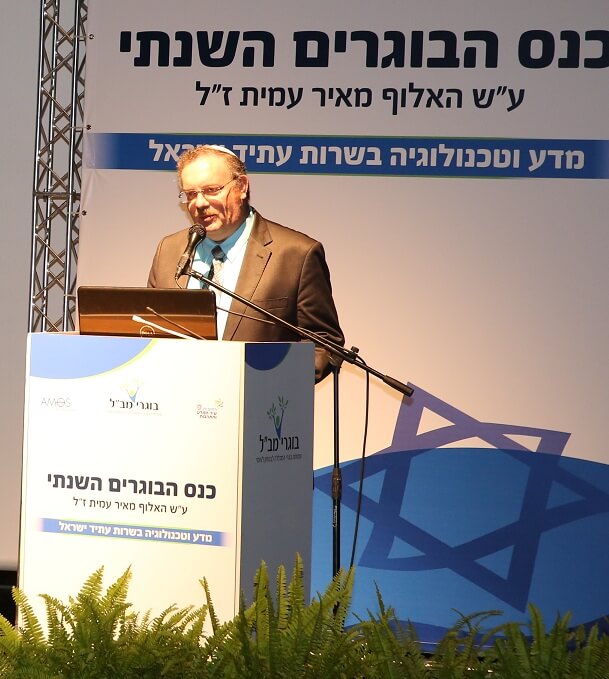The retiring Minister of Science, Prof. Daniel Hershkowitz detailed the achievements of the Israel Space Agency at the annual conference of the graduates of the National Security College

"As the Minister of Science, I am responsible for the Israeli Space Agency, which is responsible for the civilian aspect of the space program. Throughout the world, the use of space began with military applications, today the civilian share is climbing and in many countries it already exceeds 50% of the activity in space." This is what the retiring Minister of Science and Technology, Prof. Daniel Hershkowitz, said at the second annual conference of the graduates of the National Security College that took place this week at the Weizmann Institute.
"When we talk about space, we are all consumers of services such as remote sensing, telephony services, television services, GPS, few more are able to launch satellites or produce satellite systems and assemblies, ground stations, dishes and communication antennas. The Israeli industry takes part in several aspects of the food chain in the field of space, and among others, Gilat, which provides satellite communication services to ground stations, Communications Space, which provides a service of communication satellites for the aerospace industry, which produces complete satellites."
"There are several problems that characterize the space and make it a complicated occupation. Space is a very unfriendly environment, partly because of extreme temperature differences that require us to work with special materials. Another problem is the problem of radiation - ultraviolet radiation, X-rays, gamma rays and energetic particles - all from the sun and of course galactic cosmic radiation. The satellites remain in constant contact with the Earth, low-altitude observation satellites, medium-altitude GPS satellites or communication satellites orbiting the Earth at an altitude of 36 thousand kilometers require communication solutions. Waves have the property that they lose information. We communicate with the satellite and this communication is hundreds or thousands or tens of thousands of kilometers and it is important for us to receive all the communication, the answer lies in mathematics: image reconstruction and error correction algorithms."
"The space powers today are the USA, Russia, China, Europe, India, Japan and Israel. Iran recently demonstrated the ability to launch satellites and South Korea is very close to doing so."
Later, Minister Hershkovitz described the projects managed by the Israeli Space Agency: "Let's start with civilian observation satellites - at the moment it is the Eros B satellite (and the Ofek satellites, but these are not the responsibility of the AB Space Agency), what makes the Israeli observation satellites unique is that while a European observation satellite or Chinese weighs 2.5 tons, and the Americans managed to reduce it to a ton and a quarter. We are talking about a satellite that weighs less than 250 kilograms. It developed out of necessity - because from Israel it is impossible to launch eastward. Launching to the west can increase the price of the launch by 50% in front of them reducing weight by using advanced materials, advanced constructions and the miniaturization of the equipment, without compromising performance.
Another satellite that has not yet been launched is the Venus satellite - a French-Israeli collaboration. It is a super spectral satellite that includes unique systems with a resolution of a wider spectrum than that of visible light and in the spatial aspect. The satellite will be used, among other things, for agricultural monitoring by sensing from space, will detect soil and sea contamination, and more. Israel is responsible for the satellite casing and the French for the camera, but their tender was won by Alup, so it is actually a completely Israeli satellite.
The next generation of Venus will be a joint project with Italy, and will scan the ground with 256 wavelengths that enable precision agriculture, environmental quality monitoring, mineral exploration, water body monitoring and more. Other satellites are the Texar satellites that photograph with radar, and in this field the first interplanetary mission to Israel is expected (if you don't consider the Ricor refrigerator in Mercury Messenger) a radar satellite that will be placed on a spacecraft that will orbit the cloud-clad planet - Venus.
And this is in addition to the communication satellites, when the aerospace industry recently won the tender for the production of the Amos 6 satellite, and future projects of nano satellites such as the Samson project and of course SPACEIL - the Israeli team participating in the Lunar X Prize competition and trying to reach the moon by 2005.
Minister Hershkovitz also mentioned that due to Israel's status, it will host the annual convention of the Astronautics Federation in 2015, a convention attended by about 5,000 people, most of them from the space industry.

3 תגובות
Lots of spelling and syntax errors, some sentences are simply hard to understand,
Is it so difficult to read the article once before publication and correct the errors?
It happens in every second article on this site!!
The spacecraft to the moon is also a time machine? Otherwise it is unlikely that you will arrive in 2005
2005 has already passed but God willing we will reach the moon in 2015